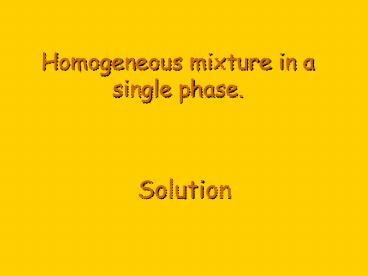Solution PowerPoint PPT Presentation
Title: Solution
1
Solution
- Homogeneous mixture in a single phase.
2
Classification of Matter
Also called solutions
Also called suspensions
3
Solvent
- Substance you have the most of. Substance that
retains its phase. Dispersing medium.
4
Solute
- Substance you have the least of. Substance that
dissolves.
5
Dilute Solution
- Relatively small amount of solute.
6
Concentrated Solution
- Relatively large amount of solute.
7
Aqueous Solution
- Water is the solvent.
8
NaCl(aq)
- Solution of NaCl dissolved in water!
9
Soluble
- Capable of being dissolved.
10
Solubility
- Maximum amount of 1 substance that will dissolve
in a given amount of another substance.
11
Factors that influence solubility
- Temperature for all systems pressure for
systems involving gases.
12
Factors that influence the rate of dissolving.
- Temperature
- Stirring or agitation
- Surface Area of solute
- Amount of solute already present
13
What kind of change is dissolving?
- Physical change
14
How does a chemist represent the dissolving of a
covalently bonded substance?
- C6H12O6(s) ? C6H12O6(aq)
15
How does a chemist represent the dissolving of an
ionically bonded substance?
- NaCl(s) ? Na1 (aq) Cl-1(aq)
16
What happens to an ionic substance when it
dissolves?
- It separates into ions.
17
What is the equation for the dissolving of CaBr2?
- CaBr2(s) ? Ca2(aq) 2Br-1(aq)
18
Molecule-Ion Attraction
- Interaction between water molecules and ions in
solution.
19
What kind of molecule is H2O?
- Polar the O end is a bit negative the Hs are
a bit positive.
20
Is the orange ion positive or negative how do
you know?
21
Is the orange ion positive or negative how do
you know?
22
Units of Solubility?
- Grams of solute per 100 grams of solvent
23
What happens to the solubility of all gases as
the temperature increases?
- The solubility of gases ? as the temperature ?
24
What happens to the solubility of most solids as
the temperature increases?
- The solubility of most solids ? as the
temperature ?.
25
What do you need to conduct electricity?
- Mobile charged particles!
26
Electrolyte?
- A substance that dissolves in water to produce a
solution that conducts an electric current!
27
Nonelectrolyte?
- A substance that dissolves in water to produce a
solution that does not conduct an electric
current!
28
Saturated solution
- Contains the maximum amount of dissolved solute
at that temperature.
29
Supersaturated solution
- Contains more than the maximum amount of
dissolved solute at that temperature.
30
Unsaturated solution
- Contains less than the maximum amount of
dissolved solute at that temperature.
31
Precipitation
- The opposite of dissolving. A solid comes out of
solution.
32
Dynamic Equilibrium
- Term used to describe a saturated solution.
Precipitation dissolving are ocurring at the
same rates. No net change.
33
How do you test a solution for saturation?
- Throw a crystal of the solute into the solution
observe what happens.
34
What are 3 possible outcomes of the saturation
test?
- Crystal dissolves Soln was unsaturated.
- No change in crystal Soln was saturated.
- Crystal gets larger Soln was supersaturated.
35
What are 3 regions of a solubility curve?
- On the trace saturated solution.
- Above the trace supersaturated solution.
- Below the trace unsaturated solution.
36
Concentration
- A number that describes how much solute compared
to how much solution or how much solvent.
37
Percent
- Part over Whole X 100
38
Molarity (M)
- Molarity moles solute
Liters of solution
39
No. of Grams
?by F.M.
X formula mass
No. of Moles
X 22.4 L/mol
X 6.02 X 1023
- by
- 6.02 X 1023
? by 22.4
No. of Particles
No. of Liters
Mole Map
40
Parts per Million (PPM)
- PPM grams solute X 1000000
grams solution
41
How much KCl will dissolve in 300 grams of water
at 50?C? Use the graph to set up a proportion.
Problem
42 g KCl X g KCl
100 g H2O
300 g H2O
X 126 g KCl
42
88 g KNO3 in 100 g H2O at 50?C.
20 g KNO3 in 100 g H2O at 10?C.
88 g 20 g 68 g KNO3 precipitates.
50? to 10? - How much KNO3 precipitates?
43
Measuring Heat of Solution
Water is the environment!
If Temperature of H2O ?, dissolving was
exothermic. If temperature of H2O ?, dissolving
was endothermic.
source
44
Factors affecting Solubility
- Temperature
- Pressure
- Nature of the Solvent Solute
45
Nature?
- Ionic
- Polar Covalent
- Nonpolar Covalent
- Like Dissolves Like
46
Nature of Solute Nonpolar Solvent Polar Solvent
Nonpolar Soluble Insoluble
Polar Insoluble Soluble
Ionic Insoluble Soluble
47
MolarityC X VolumeC MolarityD X VolumeD
MC X VC MD X VD
Dilution Problems
48
Colligative Property
- Depends on the concentration of the solute, NOT
on the nature of the solute. Does not matter if
ions or neutral particles are in solution.
49
What are 2 colligative properties?
- Freezing Point Depression Boiling Point
Elevation
50
Which solution has the most dissolved particles?
- 1 mole of C6H12O6 in 1 Liter H2O
- 1 mole of NaCl in 1 Liter H2O
- 1 mole of CaBr2 in 1 Liter H2O
51
Which solution has the highest concentration of
dissolved particles?
- 1 mole of C6H12O6 in 1 Liter H2O
- 1 mole of NaCl in 1 Liter H2O
- 1 mole of NaCl in .5 Liter H2O
52
H
-
NaCl-
--------
O
-
H
Molecule-Ion interaction in solution.

